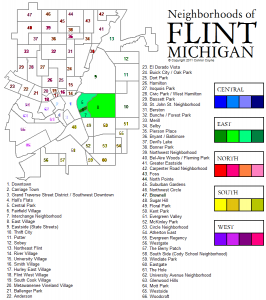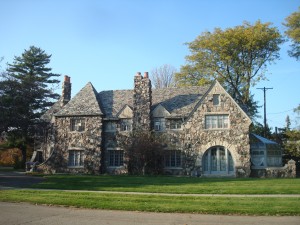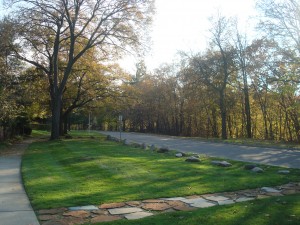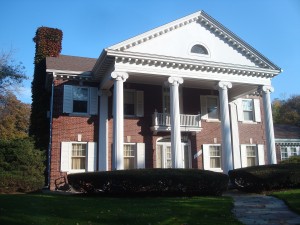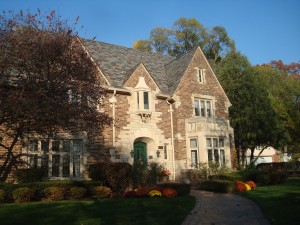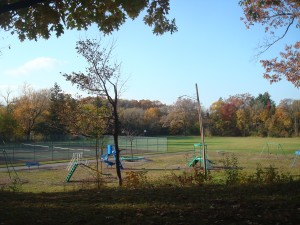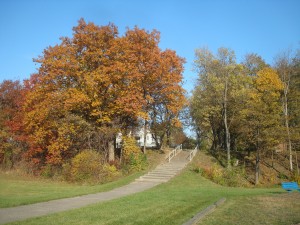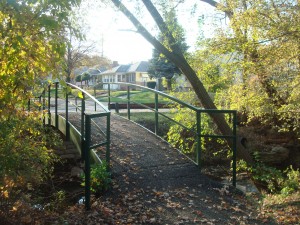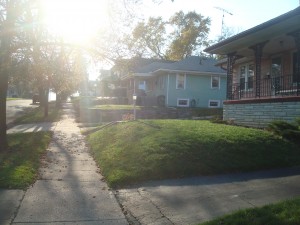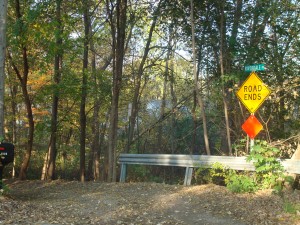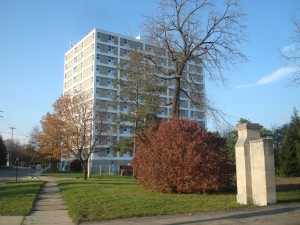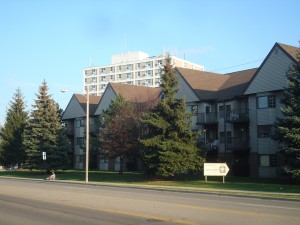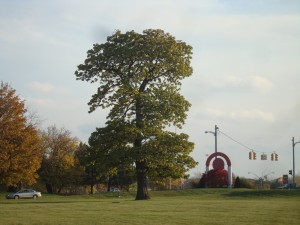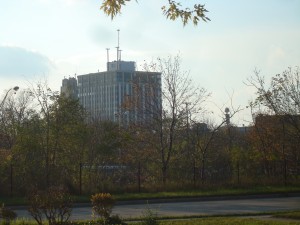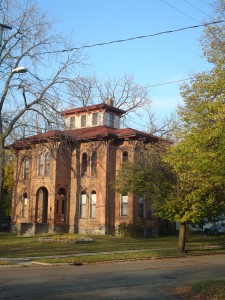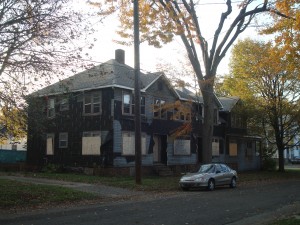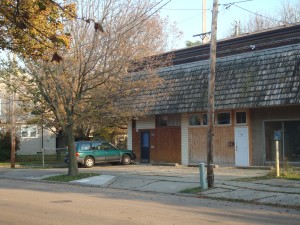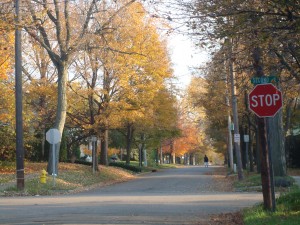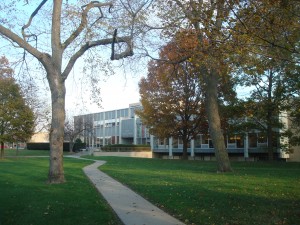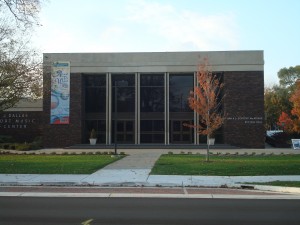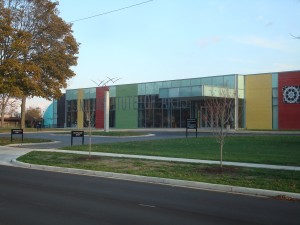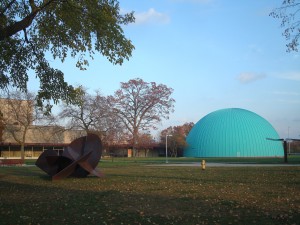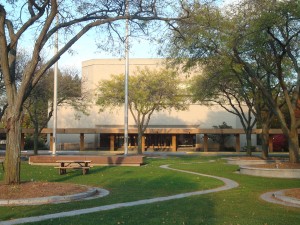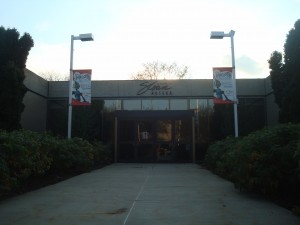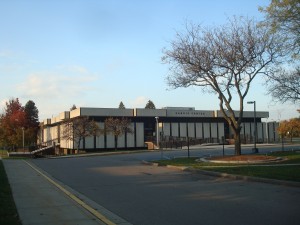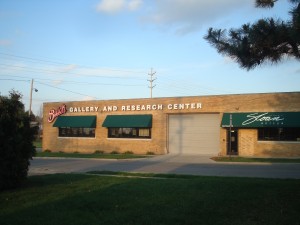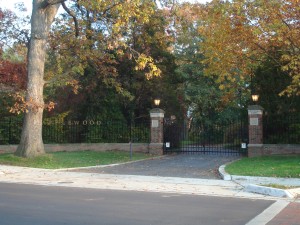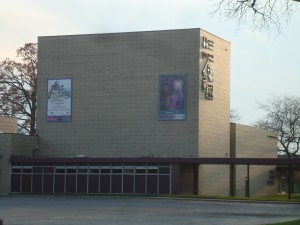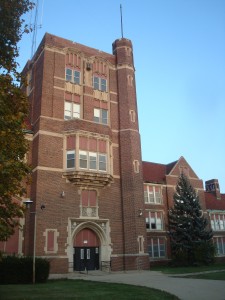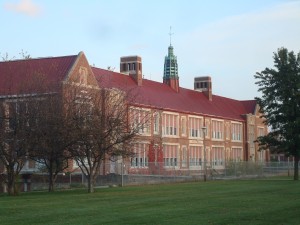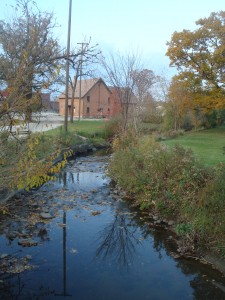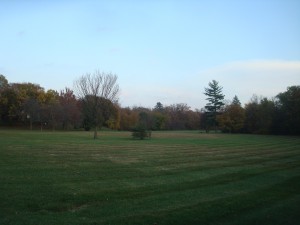This is the third and final installment of my photoblog exploration of East Village, Flint, the neighborhood where I grew up and where I now live again after being away for 21 years. The first installment — posted here — explored the area south of Court Street as well as Pierce Park. The second installment — posted here — took in Mott Community College and the neighborhood north of Court. This third trip takes in the westernmost portion of the neighborhood; everything to the west of Gilkey Greek. Because I spent a lot of time on pedestrian-only footpaths, GoogleMaps was unable to replicate my route, but this map at least shows the extent of territory I covered:
And here is how the neighborhood fits into the larger layout of Flint:
Okay, so to start off, I lied. I actually started out walking along Woodlawn Park Drive, which runs just to the east of Gilkey Creek; it was just easier to include this portion of the neighborhood in this walk than the others. The next several pictures are from the part of East Village typically identified as the “College Cultural Area.” Woodlawn Park Drive sweeps south from Court to I-69, with the park to the west, faced by grand manor houses sprawling across (for the most part) city-sized lots. The architecture is intimidating, but nevertheless a bit more restrained and urban than the wealthy Woodcroft neighborhood on the West Side.
My wife and I call this the “Clue House” because of the conspicuous conservatory, and more generally because it looks like the setting of a dinner theater-style murder mystery. I recently learned, however, that this was the grand home of the Hamady clan. The Hamady brand is as unique to Flint as Koegel’s Viennas and the Grand Funk Railroad, and even a relative youngster like myself knows what a Hamady sack is. I was delighted to learn the iconic history of this magnificent house.
Woodlawn Park Drive is spacious and curving, but it kind of springs out of nowhere, surrounded as it is by a dense neighborhood and Mott on one side, and very close to Downtown on the other.
Here are some more of the impressive houses on this street:
To a limited extent, this kind of arch style continues to the east on Woodside, West Fork, and Beard streets, and even further, but the largest houses and lots are almost entirely confined to this short stretch. The East Village as a whole is mixed-income, with Woodlawn Park representing one extreme, and this mixture is one reason why, for all its stability over the years, the neighborhood has also been one of the Flint’s most dynamic and culturally productive areas. The East Village’s diversity as well as its proximity to Downtown Flint, the colleges, and other urban amenities have ensured that there’s a lot happening in this neighborhood year round.
Woodlawn Park itself is a secluded spot nestled along Gilkey Creek and surrounded by residential streets on both sides. I-69 runs to the south of the park, but neither is visible from the other. The park is a popular place for basketball, and a rustic set of playground equipment is a favorite with kids from the neighborhood.
At the western edge of Woodlawn Park, a small footbridge crosses Gilkey Creek (the fourth such bridge in the neighborhood), and connects the College Cultural part of East Village with the Interchange Neighborhood. Another path to the north, hidden behind a small copse of oaks and maples, connects Woodlawn Park to Burroughs Park and Court Street.
The Interchange Neighborhood is bordered by (and named after) the transfer ramps for I-69 and I-475. The other borders are Court Street to the north and Gilkey Creek to the east.
All of the areas of the East Village west of Gilkey Creek have a subtly different character than the neighborhood to the east. Demographically, the area is slightly lower income and more predominately African American, particularly south of Court Street; historically this neighborhood bordered and partook of the nightlife on the black Near South Side with its famous blues clubs. Today, the neighborhood is also popular with staff and students from U of M and Mott who want to live in Flint but avoid the dorms. Many of the houses are larger here, and a solid majority are old for this relatively young town. Many houses date earlier than the 1900s, which also means that they predate the auto industry. There is only one major thoroughfare here, Lapeer Road, which itself major functions as an artery connecting Court Street to I-69 and Dort Highway.
The Interchange Neighborhood has its own little secrets and alcoves. Don’t believe this “Dead End” at the end of E. 9th Street. The paved road becomes a dirt track known as “Riverdale.” which leads through a weedy wooded area lined with some magnificent huge old houses.
On the northern edge of the Interchange Neighborhood, Richert Manor is a public-housing high-rise for seniors. It has recently received a new paint-job and makeover. It is also the tallest building in East Flint.
These condos on the corner of Court and Crapo streets has been a landmark for as long as I can remember, their sophisticated, moderne look standing out among the more worn bungalows and Victorians of the surrounding blocks. It isn’t just me, either. My realtor told me that the builder commissioned this building with his wife in mind, who has just moved to Michigan from New York, and was feeling homesick.
I’ve never been entirely certain whether the Fairfield Village apartments, stretching along Court Street between Avon and Lapeer are included in the Interchange Neighborhood. These are recent additions to the East Village, and to date the grounds appear to be clean, well-maintained, and, most importantly, well-populated.
East Street Park forms an attractive border between the East Village and Downtown. When I was graduating high school (back in 1997) I envisioned this as the site of an “Occupy”-type event, which would be called “American ESP” (East Street Park) and which would draw participants from all over the Midwest and country.
The area North of Court is called “Central Park” by its neighborhood association, after the shuttered Central High School that represents its eastern border. A northern leg of East Street Park extends into this neighborhood, and here presents a nice angle on some of the buildings Downtown. This is also where the neighborhood’s eponymous East Village Magazine is published.
An old Victorian house in Central Park. This small neighborhoods shares the distinction of the oldest and best-preserved houses with Downtown and Carriage Town.
Unfortunately, Central Park and the Interchange Neighborhood have not been insulated from quintessentially Flinty problems. Among the tiny and ramshackle yards, you’ll spot a few victims of fire and arson.
This complex used to be the site of a small party store and is still the home to the magazine. About ten years ago, high traffic and crime rates prompted residents to successfully petition for most through-streets to be replaced with cul de sacs. If one wants to enter Central Park by car today, there are only two points of entry: 3rd Street at Chavez and 2nd Street at Crapo. And once inside, one might feel unable to escape as she passes Dead End after Dead End!
On the whole, the age and density (large houses on small plots) of Central Park and the Interchange Neighborhood gives it a more “urban” feel than the rest of the East Village, and indeed, most of Flint. The majority of this city was built since the 1930s, with more provisional housing stock and more spacious yards.
The Flint Cultural Center is without question the crown jewel of the East Village neighborhood. It could reasonably be called the crown jewel of the entire city. Ten museums, theaters, cultural institutions, and park grounds sprawl on a beautiful tree-lined campus donated by the Mott family. These various organizations were financed in large part by the Mott Foundation and General Motors, but if you look at the dedication plaques within most of these buildings, you’ll see that local individuals and small businesses also played a significant part.
This is the Flint Public Library, which used to be a flagship for four other branch locations. Flint’s revenue crisis has forced the closing of the neighborhood branches, and now the main branch is only open from Tuesday through Sunday.
The Flint Institute of Music is directly across the street from the library and is home to the Flint School of Performing Arts and the Joffrey Ballet School’s Magnus Midwest Dance Intensive. Yes, that Joffrey Ballet School.
The Flint Institute of Arts is one of the region’s most impressive museums with a small but quality and wide-ranging collection, including the Bray Renaissance Gallery. The FIA also offers a popular film series, and recent exhibitions have included Pablo Picasso, Dale Chihuly, and Andy Warhol, among many others.
The Longway Planetarium is next door to the FIA and is Michigan’s largest and best-equipped planetarium, being the same size as Chicago’s Adler Planetarium. In addition to educational star shows and holidays specials, I remember the trippy alternative music laser-fests of the mid-90s. They are, sadly, a relic of the past, but there’s nothing quite like squeezing into a dark dome with 200+ new “friends” to watch glowing squiggles dance around on the ceiling to the insane bass of Primus.
Since the closure of the Capitol Theatre downtown and the demolition of the imposing IMA Auditorium, the Whiting is left as Flint’s premiere performance venue. The auditorium seats 2,000 and is where most local students (including yours truly) graduate from high school. It’s also where I met Davy Jones of the Monkees.
Across a small park from the Whiting is Sloan Museum, a fine all-purpose museum with a special focus on local history. Sloan (named after the most thoroughly GMesque of CEOs) is unique in its circumspect view of of the automobile industry. Its permanent exhibit “Flint and the American Dream” manages to avoid both the shrillness of local boosterism and the despair of local apocalyptics. If visiting friends are ever curious about what makes this city tick, this is the first place we go. (The second is usually the Atlas, and the third is probably the Torch).
The Sarvis Center is tucked back somewhat from the rest of the Cultural Center, and is used for a variety of purposes. Most compellingly, it is a second campus for Pierce School. (I’ve got a picture of Pierce’s neighborhood school in Part 1 of this series.)
Hidden away from the rest of the Cultural Center is Sloan’s Buick Gallery featuring a sharp collection of antique and concept cars.
At its eastern extreme the Cultural Center gives way to Applewood, the historic Mott estate. I can’t comment much on this one; the last time I lived in these parts, Applewood was still a private residence! However, it appears to be open for public tours and a variety of events. I do know that the estate is sprawling and gorgeous with greenhouses, apple orchards, French and English style gardens, a butterfly garden, and more.
Last but the opposite of least… moving back toward the main Cultural Center from Applewood one encounters Bower Theater and the Ann Elgood Theater, home to Flint Youth Theatre. I spent several thousand hours here in high school and college, and this is where I learned about the important, which is to say, crucial, intersection in the arts between an expansive creative vision, unrelenting rigor, a unflagging work ethic, and a constantly professional attitude. Too many artists do not realize that all of these elements need to be present in order to create consistently good work and bring it into the world in a meaningful way, and I’m grateful to FYT for teaching that important lesson. But remeniscing aside, FYT has performed original, adapted, and scripted work all over the country, including an invited performance of their play The Seventh Dream. I acted in the original performance of that same play on the stage at Bower.
Of course, I’ve indulged in a lot of bragging about the Cultural Center (as you can see there’s a lot to brag about) but the problems facing Flint are persistent, and one of the most tragic and unfortunate of those problems is symbolized by the massive thing sitting on the Center’s back porch. That “thing” is Flint Central High School. Central was Flint’s oldest high school, its most diverse high school, a high school that pioneered magnet programs in the fine arts, and alums included Casey Kasem, Jim Abbott, and LaKisha Jones. It’s a place that many of my friends called home for four years of their lives. I volunteered here as a librarians’ assistant one fall, and I attended prom at Central. In some far-off half-fantasy I always sending my own children to school at Central.
But after 134 years in two buildings, the school was shuttered in 2009 due to a dwindling student population and insurmountable restoration expenses. In terms of symbolic blows to Flint’s pride and identity, there are few moments that encapsulate the damage more thoroughly and sharply than the closure of Central.
And yet, there’s still a small bit of hope. As it turns out, on a fundamental level, the building was built too solidly for an easy or cheap demolition. I know that there are many pragmatists who would like to see this building demolished and replaced with something more modern and functional… a best case scenario here would be something in the spirit of the Mott Regional Technology Center which replaced the gorgeous St. Joseph’s Hospital. On the other hand, take a look at the Durant today… there were many (myself included) who for many years considered that landmark to be a lost cause and hoped for the building to be demolished and the land reused. I am very thankful that we were wrong.
I firmly believe that pragmatism and idealism are never binary positions; they are in constant negotiation with each other, and either is bereft of merit in the absence of the other. For many years I have thought that Flintstones need to draw some carefully chosen lines in the sand in terms of what concessions cannot be wrenched from the city. I would say that slashing public safety in a time of crisis is one such line. I would say that sitting back and acquiescing as a militant governor and state legislature illegally suspend our rights to elected representatives is another line that should be drawn. And I think that Central is a third. This school is key. That it remain a school, in some form, for someone, is key. Flint cannot survive or thrive if it surrenders what Flint Central represented, and inasmuch as Central is still the best representation — the best manifestation — of those things — the best opportunity to envision the city’s past and future within a single institution, and practice, and building… it needs to find its way home, is what I’m saying. There a safe harbor out there somewhere, and I hope we keep looking for it.
Whittier Academy (formerly Middle-School) is adjacent to Central and is just as picturesque, and also closed. The moat is my favorite feature. Not many middle schools can boast a moat.
North of Court Street, Gilkey Creek separates Flint Central and the Cultural Center from the rest of Mott’s campus.
South of Court, at the same point, Burroughs Park stretches away into the picturesque distance.
This is my home and neighborhood. It feels good to be back.
